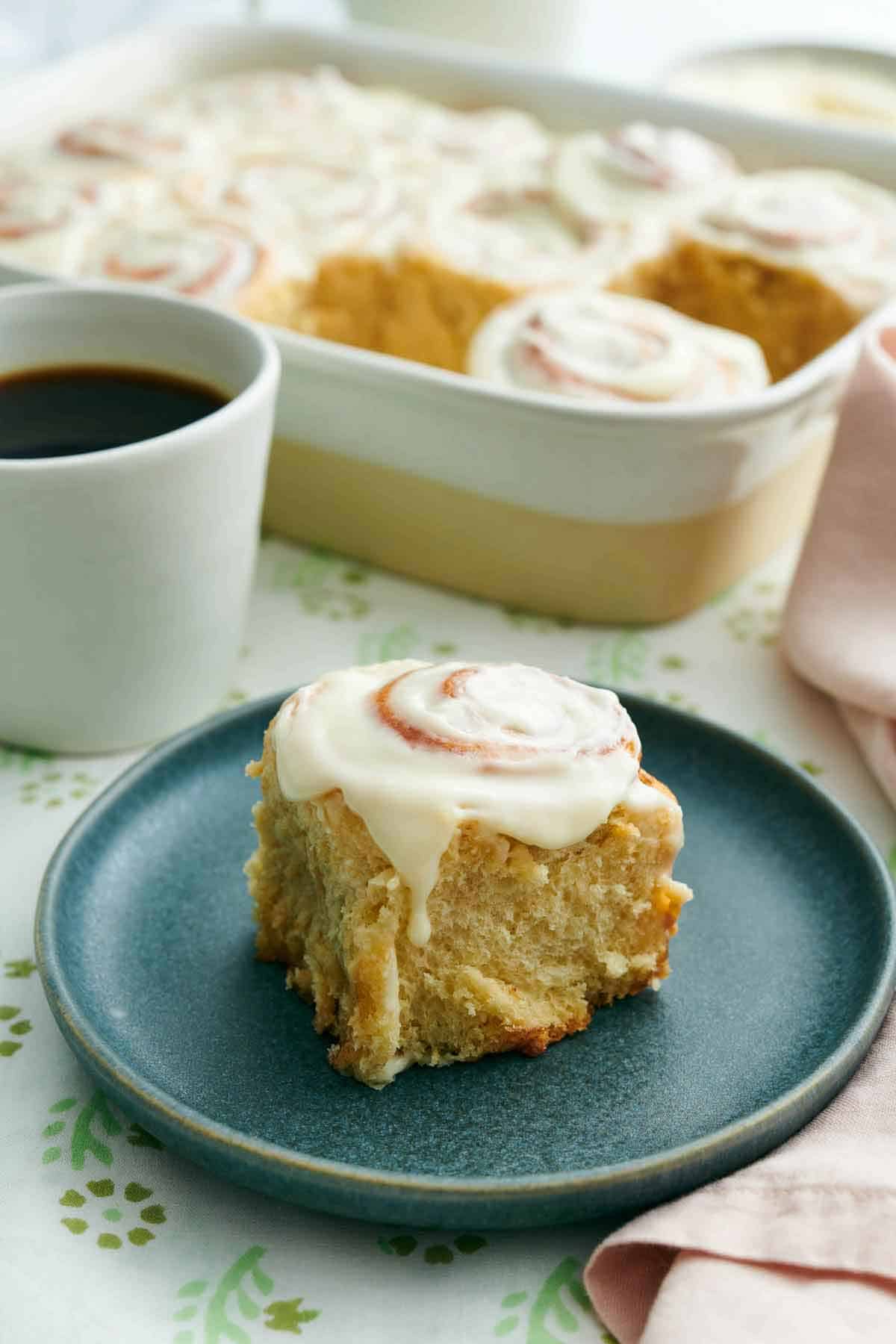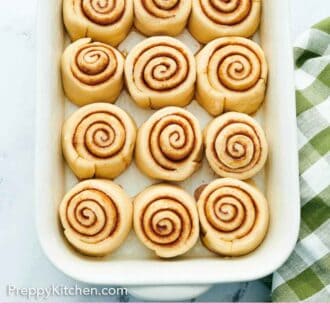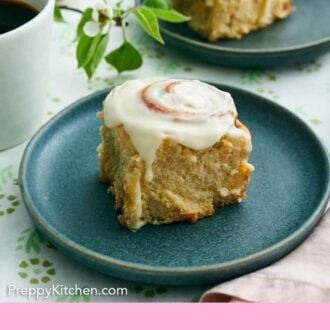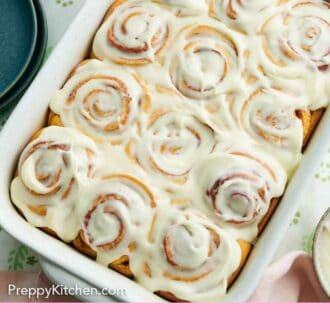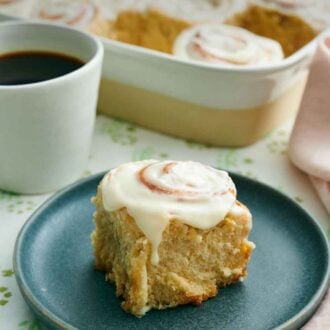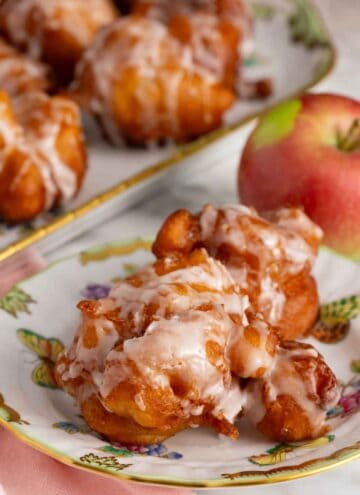Nothing says breakfast comfort food quite like a pan of warm, homemade cinnamon rolls! With wafts of sweet cinnamon and brown sugar in the air, a freshly iced pan of these fluffy rolls is simply irresistible. This honestly is the best cinnamon roll recipe (and Brian, who is a self-proclaimed but very experienced cinnamon roll expert, would agree!).
They’re fluffy, sweet, buttery, and topped with a decadent cream cheese glaze. And the best part is that they are all pillowy-softy with no hard edges in sight. If making cinnamon rolls from scratch feels intimidating, I have you covered with my best tips and tricks to make the perfect gooey cinnamon rolls every time. For more breakfast recipes, check out my sticky buns recipe, strawberry rolls recipe, and pumpkin cinnamon rolls recipe.
What You Need to Make This Recipe
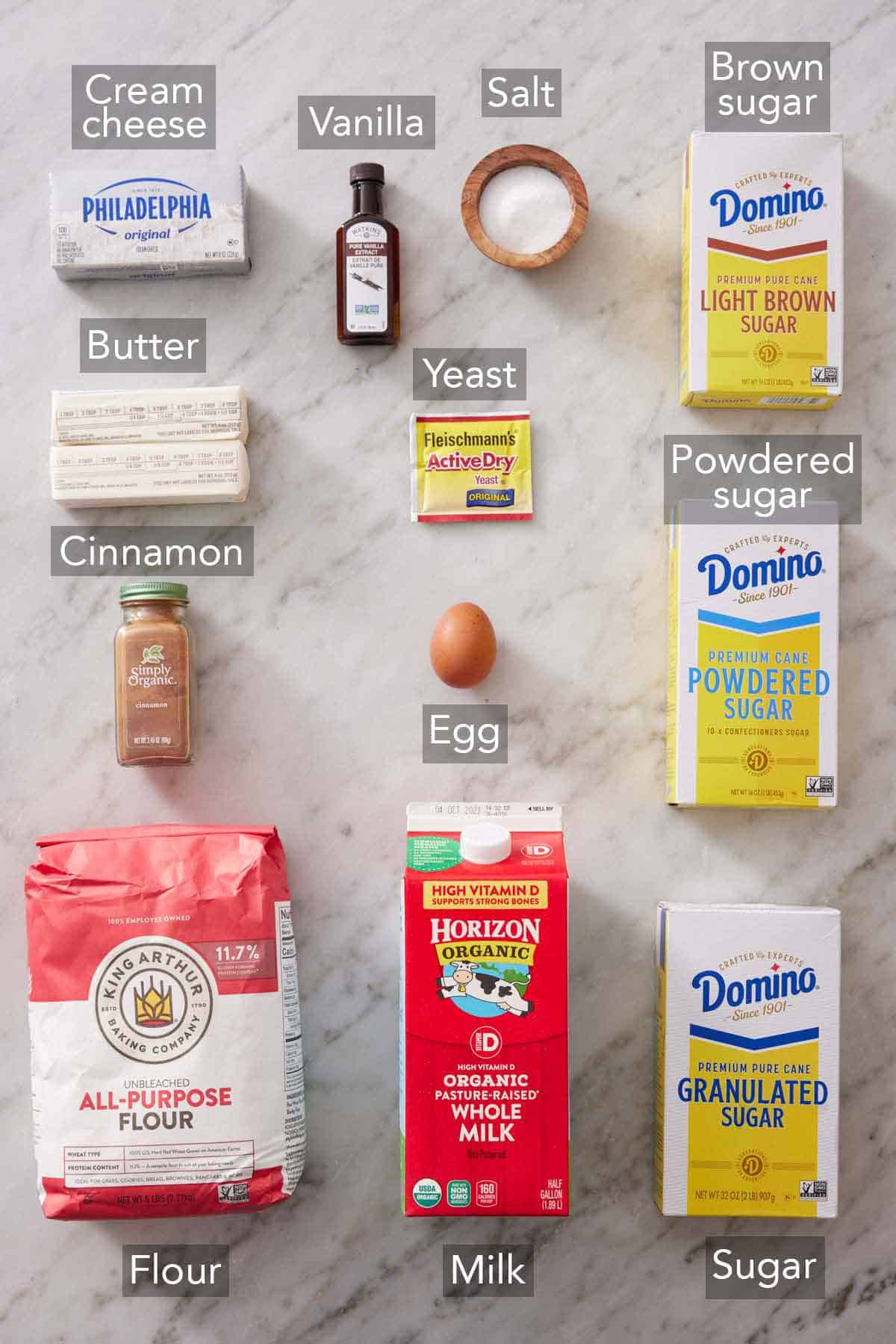
Milk – whole milk will provide the best flavored and textured cinnamon buns as the extra fat tenderizes the dough. Warm the milk to 110-120°F, or until the milk is just warm to the touch.
Active Dry Yeast – be sure to check the expiration date and that it isn’t labeled as rapid-rise or instant yeast. Expired yeast may not rise properly, and rapid-rise yeast shouldn’t bloom in hot liquid. Both of these can cause the rolls will turn out flat and dense. To keep yeast fresh the longest, store it in the refrigerator or freezer.
All-Purpose Flour – for light and fluffy cinnamon rolls, measure the flour by weighing it. If you do not have a food scale, scoop the flour into the measuring cup and level off the top for an accurate measurement.
Egg – one large egg brought to room temperature is all you need. Don’t use a cold egg, as the cold temperature can throw off the yeast’s rising process. To quickly bring an egg to room temperature, place it in a bowl of warm water for 5 minutes.
Unsalted Butter – both room temperature and melted butter are used in this recipe. Room temperature is used in the brown sugar filling, and melted butter makes the rough dough tender and rich. Always use unsalted butter, unless salted is all you have. If so, reduce the salt in the dough to a generous ¾ teaspoon if opting for salted butter.
How to Make Cinnamon Rolls
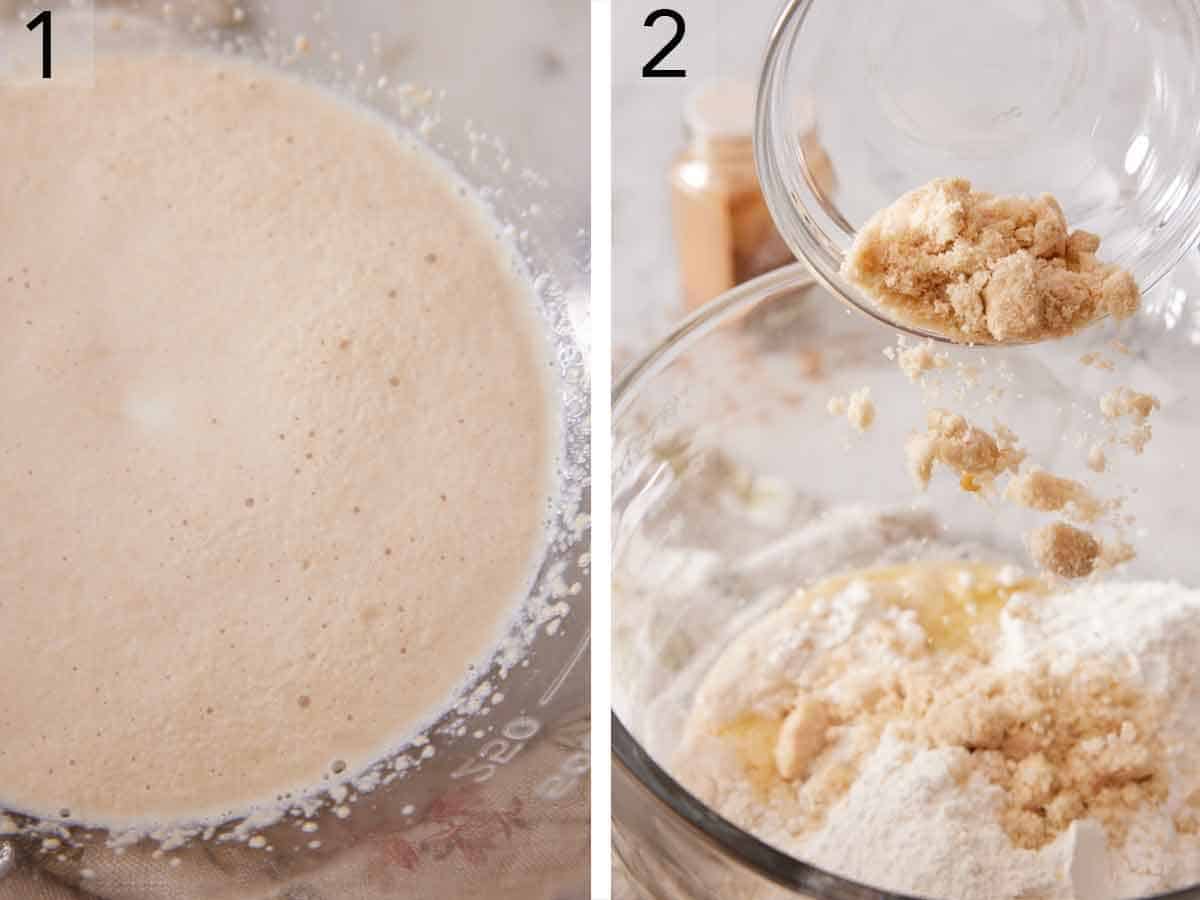
1. In a large mixing bowl or the bowl of a stand mixer fitted with a dough hook attachment, stir together the warm milk, granulated sugar, and yeast. Let sit until foamy, or for about 5 minutes.
2. Add the all-purpose flour, brown sugar, melted butter, egg, vanilla extract, salt, and cinnamon to the yeast mixture. Mix together on low speed until the dough starts to come together. Increase the speed to medium-low and continue kneading until the dough is springy and tacky to the touch but doesn’t stick for your fingers, or for about 8 to 10 minutes.

3. Transfer the dough to a lightly oiled bowl. Cover with plastic wrap or a dish towel and place the dough in a warm place until doubled in size, or for about 1 ½ to 2 hours, for the first rise.
4. Lightly grease a 9×13-inch baking dish with butter or cooking spray. Turn the dough out onto a well-floured surface. Roll the dough into roughly a 12×24-inch rectangle.
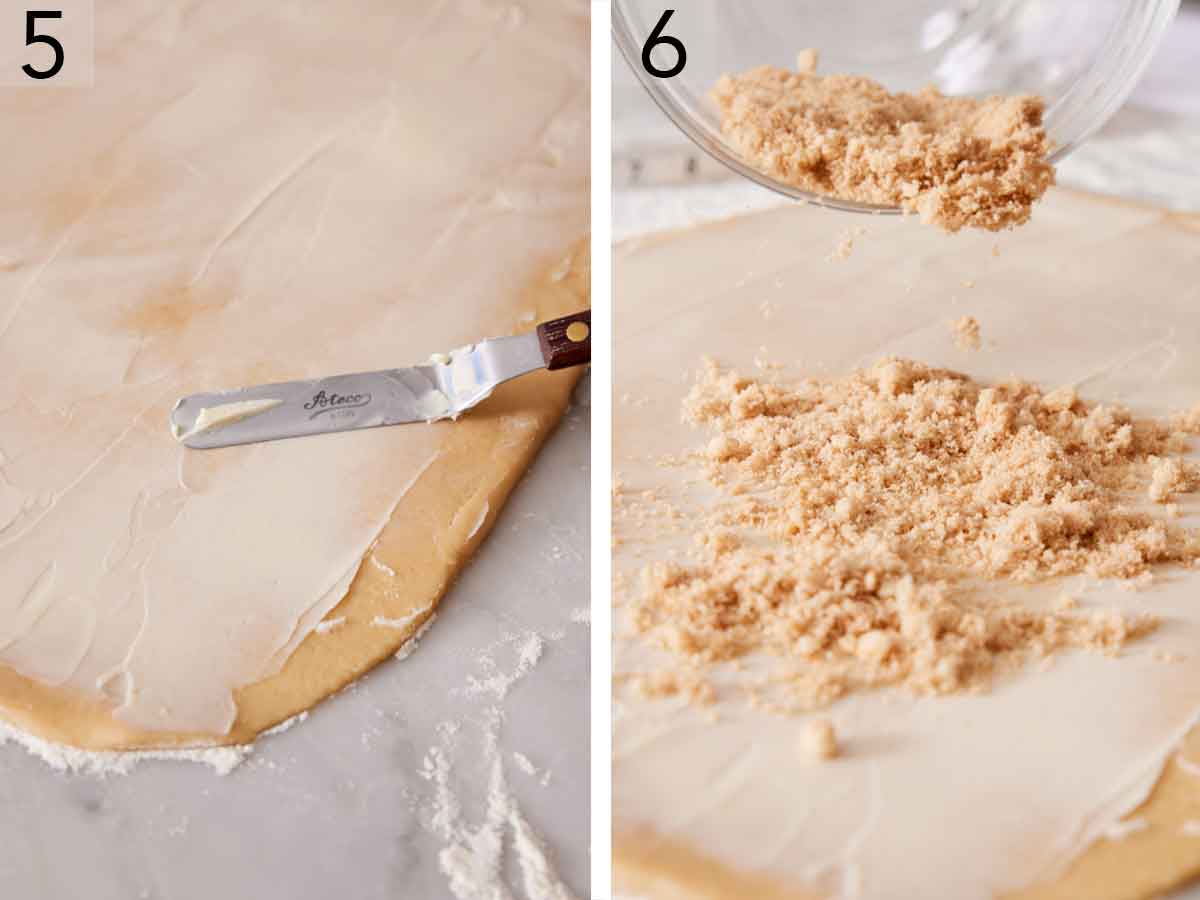
5. Spread the room temperature butter onto the cinnamon roll dough in a thin and even layer, leaving a ½-inch border down on long side of the dough.
6. In a small bowl, stir together the brown sugar and cinnamon until combined. Sprinkle the sugar evenly over the buttered dough.
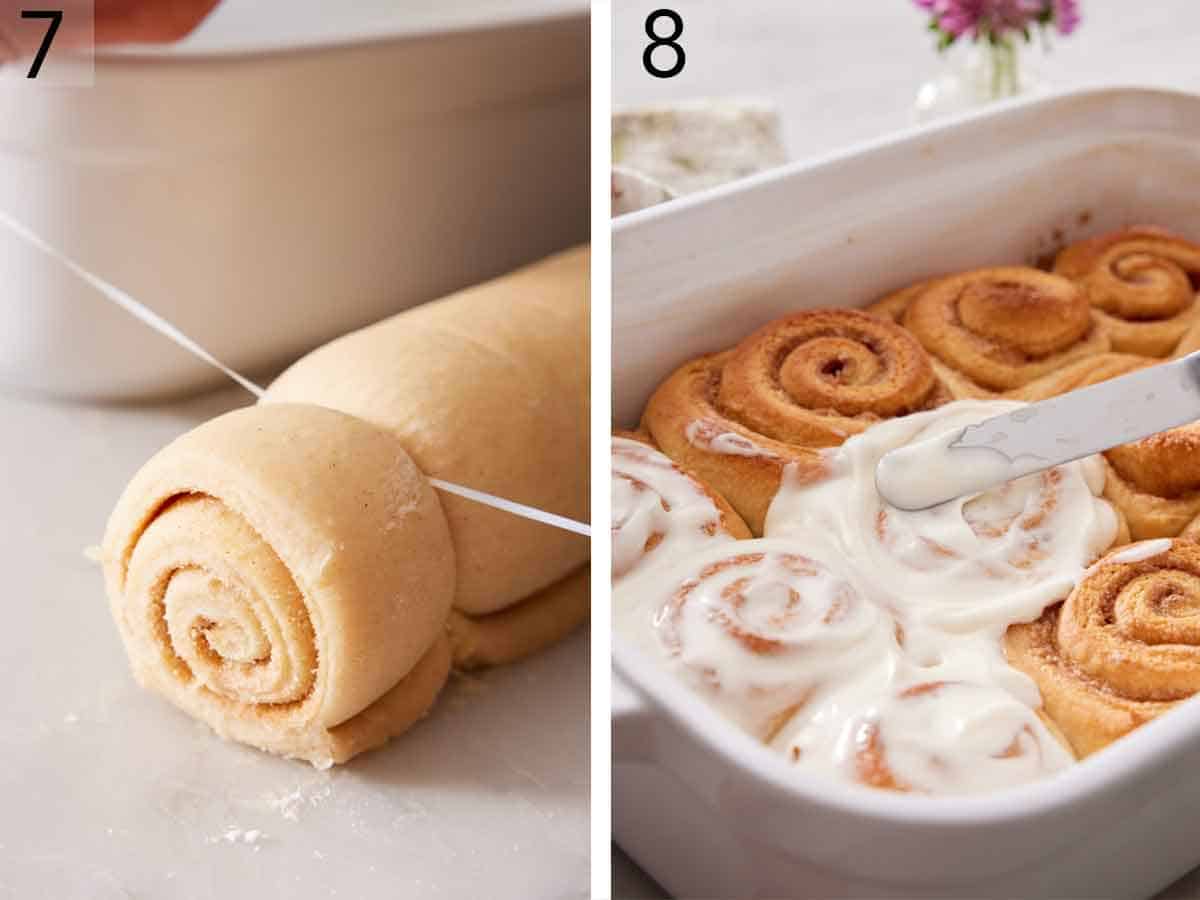
7. Starting at one long end opposite of the unbuttered border, roll up the dough into a tight log. Using a serrated knife or unflavored dental floss, cut the log into 12 equal pieces, each about 1½ inches wide. Place the rolls cut side-down and evenly spaced in the prepared baking dish. Loosely cover the dish and let rise in a warm place until doubled in size, or for about 1 hour.
8. While the dough rises, preheat the oven to 350 degrees Fahrenheit. Uncover the rolls and bake for 20 to 25 minutes, or until golden brown on top. Place the buns on a wire rack to cool. Meanwhile, beat the cream cheese, butter, vanilla, and salt together in a medium mixing bowl until smooth. Sift in the powdered sugar and beat on low speed until well combined.
If desired, thin the frosting with 1 to 2 tablespoons of milk. Spread ⅓ of the frosting on the warm rolls as soon as they come out of the oven. Let them cool for 5 more minutes, and then spread the rest of the frosting on top. Enjoy the cinnamon rolls warm!

Baking With Yeast For Beginners
There are two common types of dry yeast– active dry and instant yeast (also called rapid-rise yeast).
- Active dry yeast must be activated by dissolving it in warm water first and allowing it to bloom, or sit until foamy, before adding it to dry ingredients. It also grows more slowly, so the rise times are longer and can be drawn out even more when placed in a cold environment like the refrigerator. This yeast is ideal for making overnight cinnamon rolls and produces baked goods with a deeper flavor.
- Instant yeast can be added to a recipe without being activated first and should not be bloomed like active dry yeast. However, it’s not the ideal choice if you want to hold dough in the fridge for several hours. It is intended to speed up the rising time for yeasted doughs to bake sooner, typically cutting rise times by half. Doughs made with instant yeast can overproof much more easily so keep an eye on them!
For this recipe, I prefer active dry yeast because I often assemble the rolls and hold them in the refrigerator overnight to bake off fresh in the morning. If you would like to make these rolls more quickly, use instant yeast instead and stir it together with the milk and sugar. Skip the 5-minute activation time and immediately move to Step 2. The rise times will be much faster, so check them after 30 minutes for each rise.
The Best Way To Cut Cinnamon Rolls
Dental floss is not the most common kitchen tool, but it is the ideal item for cutting perfect cinnamon rolls! Choose unflavored dental floss so your rolls don’t have a minty taste.
To cut the rolls, mark out each one with the blade of the knife down the dough log so you end up with even slices. Slip the dental floss under the dough log at a mark, pull the ends up, and cross them over the dough, then pull firmly and quickly in opposite directions until the floss has cut all the way through the dough. You should have a clean cut and round slice! If you don’t have dental floss, use a large sharp serrated knife (like a bread knife) to cut each slice. Use long cutting strokes to reduce smashing the layer.
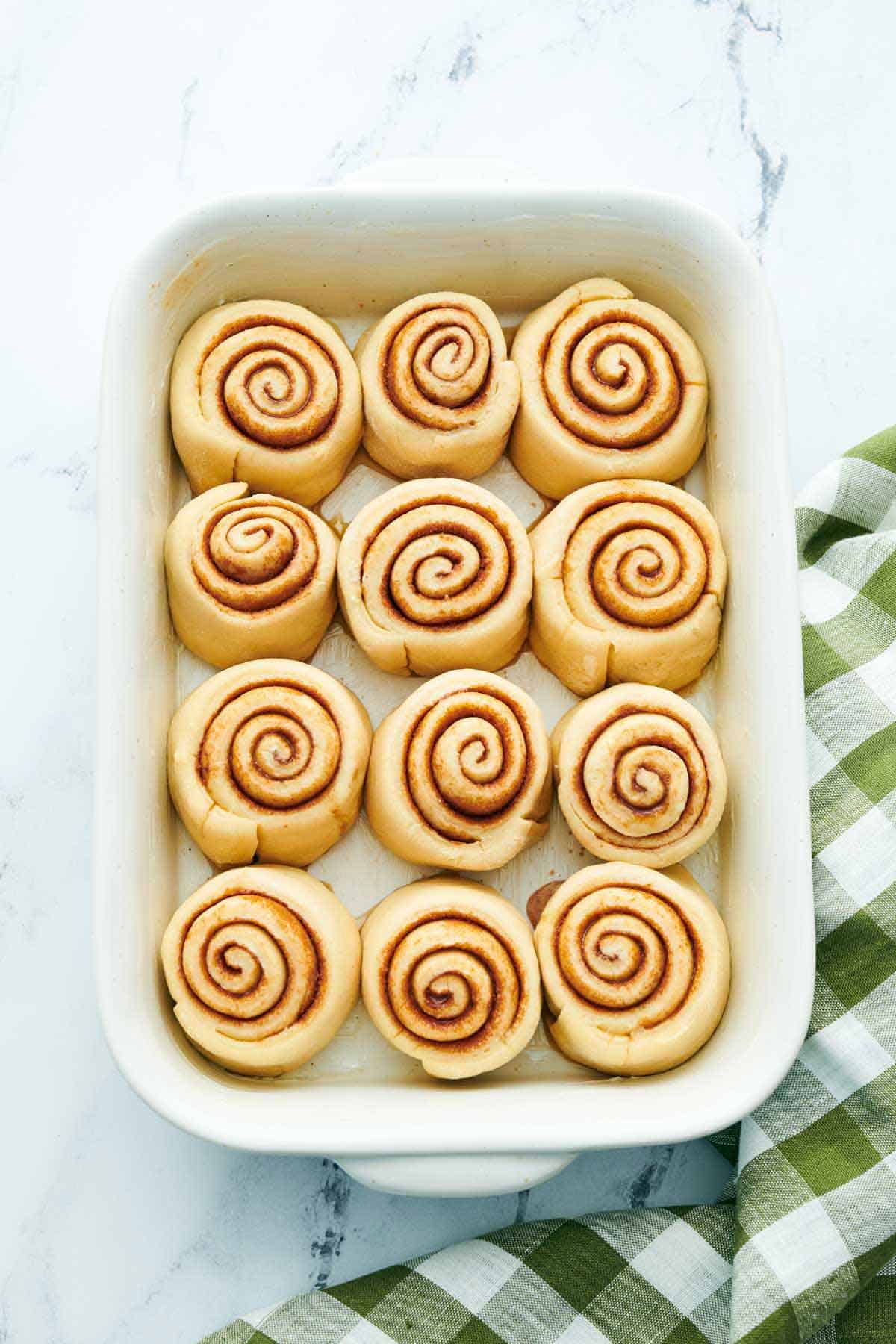
How To Make Overnight Cinnamon Rolls
This is the perfect recipe to assemble at night and bake the next morning. To make overnight cinnamon rolls, shap the rolls, cut them, and place them in the prepared baking pan before covering them with plastic wrap and refrigerating for up to 18 hours. Making them ahead like this allows you to skip the second rise, as they will rise in the fridge. When ready to bake the buns, remove the pan from the fridge and let them come to room temperature for an hour. Once at room temperature, uncover the rolls and bake as directed.
Can I Freeze The Cinnamon Rolls Before Baking?
Yes! Shape and cut the rolls, placing them in a prepared baking dish that is also freezer-safe.loosely cover, and let the rolls rise until almost doubled in size, about 1 hour. Tightly wrap the dish in plastic wrap, then a layer of foil, and freeze for up to 3 months. Thaw in the fridge overnight or for at least 12 hours and up to 24 hours. When you are ready to bake, place the pan at room temperature or in a warm spot for 1 hour, remove the wrapping, and bake as directed.
Why Are My Cinnamon Rolls Not Fluffy?
Though there are a handful of potential reasons why the rolls are not fluffy, the most common are that too much flour was added to the dough or enough time wasn’t given to let the dough rise properly. The bread will become dense, heavy, and dry if too much flour is added to the dough while kneading. To prevent this, add the flour to the kneading surface in small amounts, allowing the flour to be worked in before determining if you need more flour.
Secondly, if the dough doesn’t rise enough, the dough will be dense instead of light and fluffy. Allow the buns to double in size before placing them in the oven. A trick to know that they have risen sufficiently is to take a before photo to which you can compare the risen buns.
Tips For Making The Best Cinnamon Rolls
- Kneading options. If you have a stand mixer, knead the dough with the dough hook attachment. Otherwise, you can knead the dough on a lightly floured surface or counter. Give the dough a good long kneading – at least 8 to 10 minutes – or until it stretches evenly and doesn’t stick to your hands or the counter.
- Proof the dough in a warm but not hot place. The ideal proofing temperature is around 75°. I often proof the rolls in the oven with the heat off but the oven light on. Other great places are on a sunny counter, on top of the refrigerator, or in any other warm place in your house or kitchen.
- Spread the rolled dough with very soft, room-temperature butter. If it is still firm, microwave it in 5-second intervals until it is easily spreadable.
- Use a ceramic or glass baking pan. Using ceramic or glass creates the softest rolls. Metal conducts heat better and can dry out the rolls on the edges and corners of the pan. They will still bake up fine in metal, but they won’t all be as soft and the outer rolls will have more of a crust.
- Frost the rolls in two steps. This will allow the frosting to melt into the layers of the swirl while also accumulating on top. Swipe ⅓ of the cream cheese frosting over the hot buns immediately after they come out of the oven; spread on the rest of the frosting 5 minutes later, after the buns have cooled slightly.
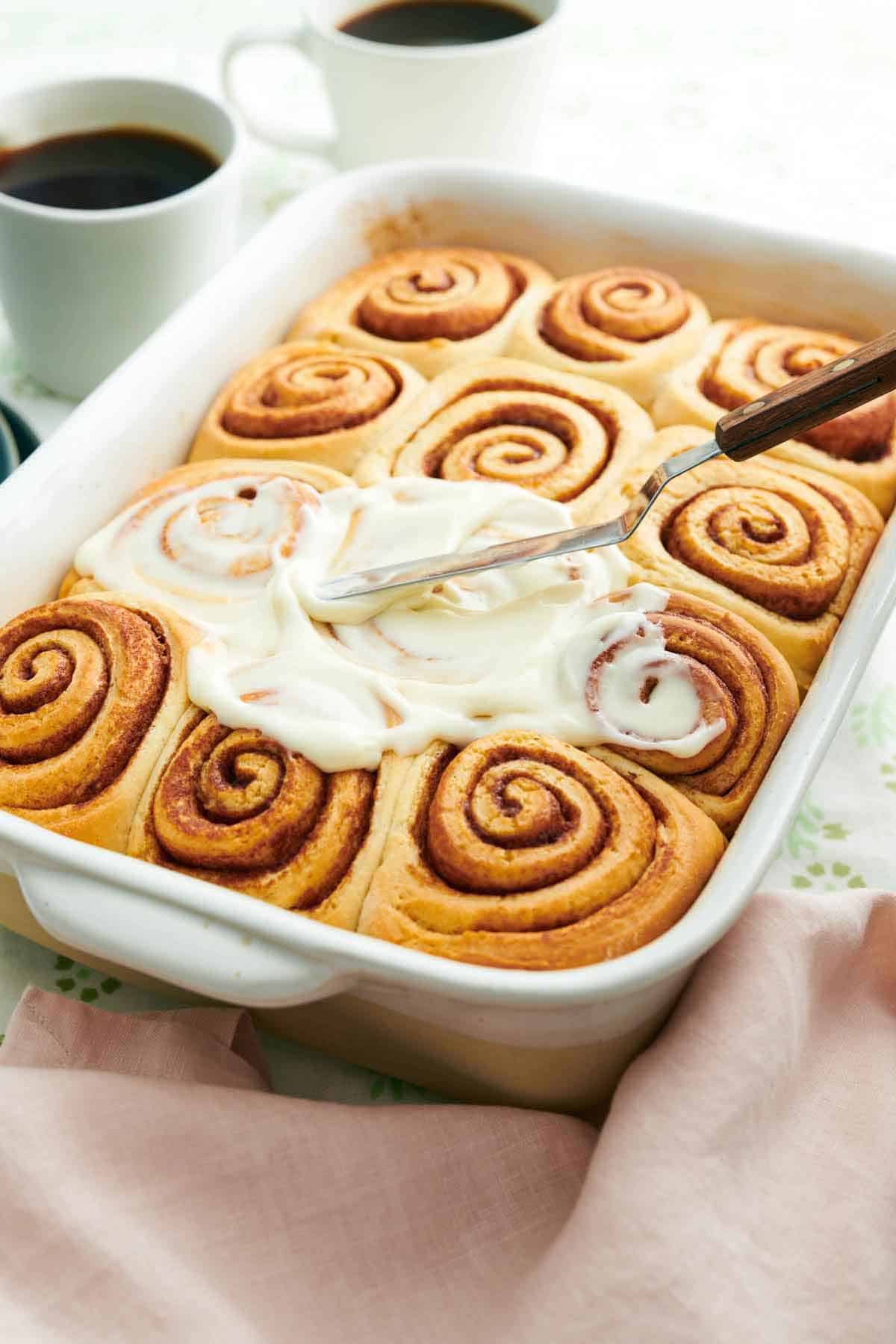
Frequently Asked Questions
Store leftover iced rolls in an airtight container at room temperature for 2-3 days or in the refrigerator for up to 1 week. The rolls can also be frozen in a freezer-safe container for up to 3 months. Defrost the rolls at room temperature for 2-3 hours, or until thawed.
Serve cinnamon rolls warm with hot tea, freshly brewed coffee, orange juice, or hot chocolate. On hungry mornings, plate the cinnamon rolls with sliced fruit, yogurt, and even scrambled eggs for a complete breakfast.
You can try it, but I have not tested it! For store-bought cup-for-cup gluten-free baking flours, you can substitute the weight of the gluten-free flour 1:1 for the weight of all-purpose flour. You will, however, need to adjust the amount of liquid.
Typically, gluten-free flour needs an additional 2-3 tablespoons of liquid per cup than all-purpose wheat flour. This is where I caution the swap in the recipe. If you want to try it, increase the milk by ⅔ cup (160ml), adding an additional tablespoon at a time as needed when mixing the dough
If you’ve tried this Cinnamon Rolls recipe, then don’t forget to rate it and let me know how you got on in the comments below. I love hearing from you!

Cinnamon Rolls
Video
Equipment
- Mixing Bowls
- Stand mixer
- 9×13-inch baking pan
- Rolling Pin
Ingredients
For the Dough:
- 1 cup warm milk (110-120F) (240mL)
- 5 tablespoons granulated sugar (63g)
- 2¼ teaspoons active dry yeast (.25oz/7g packet)
- 4⅔ cups all-purpose flour plus more for dusting (560g)
- ⅓ packed light brown sugar (73g)
- ½ cup unsalted butter melted (113g)
- 1 large egg room temperature
- 1 tablespoon vanilla extract
- 1½ teaspoon salt
- ½ teaspoon cinnamon
For the Filling:
- 6 tablespoons unsalted butter room temperature (85g)
- ½ cup light brown sugar (110g)
- 1½ tablespoons cinnamon
For the Glaze:
- 4 ounces cream cheese room temperature (113g)
- 2 tablespoons butter room temperature
- 1 teaspoon vanilla extract
- Pinch of salt
- 2 cups powdered sugar (240g)
- 1 to 2 tablespoons milk
Instructions
For the Dough:
- In a large mixing bowl or the bowl of a stand mixer fitted with the dough hook attachment, stir together the warm milk, granulated sugar, and yeast. Let stand until foamy, about 5 minutes.
- Add the remaining ingredients. Begin mixing on low speed until the mixture starts to come together. Increase the speed to medium-low and continue kneading until the dough is springy and tacky to the touch but doesn’t stick to your fingers, 8 to 10 minutes.
- Transfer the dough to a lightly oiled large bowl. Cover and let rise in a warm place (about 75F) until doubled in size, about 1½ to 2 hours.
- Lightly grease a 9×13-inch baking pan with butter or baking spray
- Turn out the dough onto a well-floured surface. Roll the dough into roughly a 12×24-inch rectangle.
For the Filling:
- Spread the butter onto the dough in a thin and even layer, leaving a ½-inch border down one long side of the dough. (make sure your butter is very soft! If it’s still firm, microwave it in 5-second increments until easily spreadable.)
- In a small bowl, stir together the sugar and cinnamon. Sprinkle the cinnamon sugar all over the butter.
- Starting at one long end opposite the unbuttered border, roll up the dough into a tight log. Cut the log into 12 equal pieces (about 2 inches wide) using a sharp serrated knife or unflavored dental floss.
- Place the rolls cut side down evenly spaced in the prepared baking dish. Loosely cover and let rise in a warm place until almost doubled in size, about 1 hour.
- Preheat the oven to 350F while rising.
- Uncover and bake for 20 to 25 minutes or until lightly browned on top. Place on a wire rack to cool.
For the Glaze:
- While the rolls are baking, combine the cream cheese, butter, vanilla and salt in a medium mixing bowl. Beat together on medium speed until smooth. Sift in the powdered sugar and beat on low speed until well combined. For a thinner consistency, beat in 1 to 2 tablespoons of milk.
- When the rolls are right out of the oven, spread a third of the glaze over the hot rolls. Let cool for 5 minutes, then spread the remaining glaze on top. The rolls are best enjoyed warm but can be covered and stored at room temperature for 2 days.
Notes
- Kneading options. If you have a stand mixer, knead the dough with the dough hook attachment. Otherwise, you can knead the dough on a lightly floured surface or counter. Give the dough a good long kneading – at least 8 to 10 minutes – or until it stretches evenly and doesn’t stick to your hands or the counter.
- Proof the dough in a warm but not hot place. The ideal proofing temperature is around 75°. I often proof the rolls in the oven with the heat off but the oven light on. Other great places are on a sunny counter, on top of the refrigerator, or in any other warm place in your house or kitchen.
- Spread the rolled dough with very soft, room-temperature butter. If it is still firm, microwave it in 5-second intervals until it is easily spreadable.
- Use a ceramic or glass baking pan. Using ceramic or glass creates the softest rolls. Metal conducts heat better and can dry out the rolls on the edges and corners of the pan. They will still bake up fine in metal, but they won’t all be as soft and the outer rolls will have more of a crust.
- Frost the rolls in two steps. This will allow the frosting to melt into the layers of the swirl while also accumulating on top. Swipe ⅓ of the cream cheese frosting over the hot buns immediately after they come out of the oven; spread on the rest of the frosting 5 minutes later, after the buns have cooled slightly.


